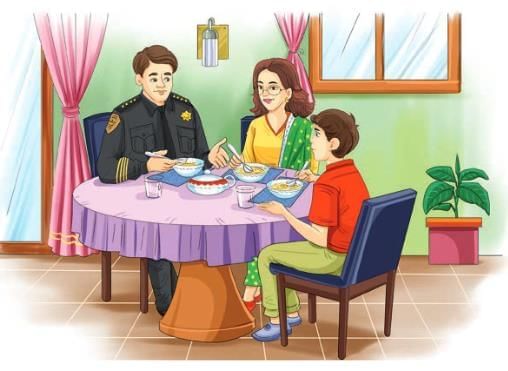Short and Long Answer Questions: The Case of the Fifth Word | English Poorvi Class 8 - New NCERT PDF Download
Short Answer Questions
Q1. Why did Chief Brown often turn to Encyclopedia for help in solving cases?
Ans: Chief Brown was a capable officer, but sometimes he faced mysteries without clear evidence. Instead of wasting time, he discussed them at home during dinner. Encyclopedia, with his sharp mind and knowledge, could spot small details that others missed. His logical questions often uncovered hidden meanings in clues. This made him an invaluable secret helper to his father.

Q2. What was suspicious about Tim Nolan’s will?
Ans: The will itself was normal as it left all his property to Davenport. However, clipped to it was a strange sheet with four puzzling words. Chief Brown suspected it was a coded message because Nolan and Davenport were linked to the robbery. The strange note indicated that Nolan wanted to leave Davenport a final clue about the hidden jewellery.
Q3. How did Mrs. Brown try to interpret the four words?
Ans: Mrs. Brown, a former teacher, looked at the words as literal terms. She explained “Nom” as nominative, “Utes” as a tribe, “Sweden” as a country, and “Hurts” as simply ‘hurts.’ But her explanation didn’t connect with the case. She admitted defeat and waited for Encyclopedia’s insight, proving that his way of thinking was sharper and more practical.
Q4. How did Encyclopedia Brown link the four words to the days of the week?
Ans: Encyclopedia noticed that the words were clipped from a calendar sheet, which gave him the clue. He realized each strange word was made by dropping “day” from the names of weekdays. “Nom” stood for Monday, “Utes” for Tuesday, “Sweden” for Wednesday, and “Hurts” for Thursday. Therefore, the missing fifth day was Friday.
Q5. Why was the young fir tree in Nolan’s nursery so important?
Ans: The fir tree was connected to the fifth word in the code, “Fir” for Friday. Nolan had cleverly hidden the jewellery in a jug of earth under this tree. Only someone who cracked the code would know to look there. Thus, the fir tree became the final piece of the puzzle that solved the mystery.
Q6. How did Encyclopedia prove himself as a brilliant detective in this case?
Ans: Unlike others, Encyclopedia didn’t get confused by the strange words. He calmly thought about the context of the note, the calendar sheet, and the hidden meaning. By asking one sharp question about the fir tree, he uncovered the entire code. His ability to connect unrelated details and find simple logic behind complex clues showed his brilliance.

Long Answer Questions
Q1. How did Nolan and Davenport’s past and friendship contribute to Chief Brown’s suspicion?
Ans: Nolan and Davenport met in prison and shared a friendship based on crime. Nolan started a palm-tree nursery after his release but earned very little, while Davenport joined him just before the jewellery robbery. During the hold-up, one robber’s mask slipped, and a clerk thought it was Nolan. Though the evidence was not strong enough for arrest, Chief Brown remained convinced of their guilt. When Nolan died leaving all his property to Davenport, along with a coded message, the suspicion grew stronger. Their friendship, timing of events, and sudden inheritance pointed towards their long-hidden crime.
Q2. How did Encyclopedia Brown decode the mysterious message left by Nolan?
Ans: The four strange words—Nom, Utes, Sweden, Hurts—puzzled everyone, including Mrs. Brown. But Encyclopedia noticed that the message was written on a calendar sheet. This gave him the idea that the words stood for weekdays with “day” removed: Monday, Tuesday, Wednesday, and Thursday. The unwritten fifth day was Friday, which became the key. He then linked “Friday” with “Fir,” and immediately asked if a young fir tree was in Nolan’s nursery. His brilliant deduction revealed that the jewellery was hidden under that tree, solving the case completely.
Q3. What qualities of Encyclopedia Brown are highlighted in this case, and why do they make him an extraordinary detective?
Ans: This story highlights Encyclopedia’s intelligence, logical thinking, and sharp memory. Unlike others, he stayed calm and searched for a pattern in the mysterious words. He was observant enough to notice the calendar sheet, which others overlooked. His ability to make connections quickly and ask the right question showed his analytical mind. Despite being just an eighth grader, he displayed confidence and maturity in solving a case linked to a major robbery. His modesty also stood out, as he never boasted about his abilities. These qualities made him extraordinary and earned him silent respect from his father.
|
60 videos|520 docs|57 tests
|
FAQs on Short and Long Answer Questions: The Case of the Fifth Word - English Poorvi Class 8 - New NCERT
| 1. What is the significance of understanding the fifth word class in language studies? |  |
| 2. How can identifying the fifth word class improve language skills? |  |
| 3. What are some examples of words that belong to the fifth word class? |  |
| 4. How does the fifth word class differ from traditional word classes? |  |
| 5. Why is it important for students to learn about the fifth word class in their curriculum? |  |















